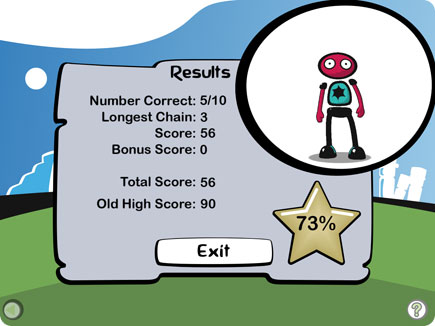- Site: futureU
- Publisher: Aspyr Media
- Developer: Aspyr Media
- Genre: Kids & Learning
By Brad Cook
Success on the SAT Reasoning Test (formerly the Scholastic Assessment Test (SAT)) is a vital part of any high school student’s college application process, but preparing to take the four-hour battery of questions doesn’t need to be nerve-racking. In fact, it can be an enjoyable experience, complete with soothing music, a low-key approach to the practice questions, and an encouraging coach.

Admission to futureU is simple: Create an account and decide the look for your avatar, who guides you through the reading, writing, and math games and encourages you to succeed. A flash card question begins each class at futureU, where you can also practice test-taking strategies, such as quickly figuring out which questions to skip or eliminating the obviously wrong answers before taking a stab at the correct one.
The First Two R’s
The Reading area of the curriculum, which helps you prepare for the Critical Reading and Writing sections of the SAT, is broken into two parts: Glyph and Predictions. The former breaks a word into two parts; drag the Glyph Stones representing their meanings to the correct spots in the answer. For example, the word “navigator” contains the roots “nau, nav” and “or.” What do they mean? If you answered “ship, sailor” and “partaker,” you would be correct.
In Predictions, read a passage and write the words that fill in the blanks. Then match those words to the best answer from a set of four choices. You complete five of them at a time, so remember the context of your guesses when perusing the answers. Predictions builds on your knowledge of such concepts as main idea, specific and implied information, technique, themes, and more.
The Writing part of your SAT prep class contains two types of games that help you practice for the Sentence and Paragraph Improvement portions of the SAT’s Writing section. In Ante Up Grade, you choose your challenge level — one, three, or five — and select the response that best fills the blank in a sentence. Decide how confident you are in your answer, on a scale from one to ten — if you’re correct, your point total equals your challenge level plus your confidence. You can only use confidence point values once each, however, so assign high numbers to questions that you’re the most confident about answering.
Writer Wrong presents you with a passage and a spinning wheel. Decide if the text has an error and stop the wheel on “Yes” or “No.” If the text has an error, the wheel spins again; stop it on the letter that corresponds to the error’s location. Finally, halt the wheel one more time to select the right correction for the mistake. You earn points for each stage of a question, just like on the SAT.
And Arithmetic
The Math portion of the SAT includes Grid-ins, which increase your score if you get them right; wrong answers are penalty-free. futureU prepares you for them with Grid Swap. Read all four problems, then rearrange the numbers on a grid so they correspond with the correct answer for each question. Some questions include related images, so be sure to click the eye to view them.
In Connections, you learn how to maximize the available time by concentrating first on the problems you can solve quickly. Since you’re not penalized on the SAT for questions you skip, spend your limited amount of time as efficiently as possible. The concepts covered in Connections include sequences, geometric equations, polynomials, and more.
Tricky Madeline
Between SAT prep sessions, relax with a couple low-key activities. In the Quick Quiz area, tackle 15 problems based on the Critical Reading, Writing, or Math sections of the SAT, or from a mix of the three. Solve the problems in any order and press Finish to see how well you did.
Test-taking skills are just as important on the SAT as the knowledge you bring to the exam, so click on the Test Skills area for two more activities. In Wrong, you’re presented with 15 questions and must mark up to four wrong responses for each one; this technique helps you quickly eliminate incorrect answers so you can focus on choosing the right one. In Skipper, choose five out of 20 questions to skip; select the ones that are the toughest, as you would do while taking the SAT.
Now excuse us while we try to figure out how many total items Madeline bought when she went to the store and purchased 36 items at $5 or less, while 70% of them were more than $5 each. This might take a while.
Note: This game is also available for download from GameAgent.
Game Hardware
Check out our systems for your best gaming experience.

Writer Wrong. The passage contains an error, so your next steps are to identify it and choose the proper correction.

Glyph. Root word mastery is a key part of the SAT.

Connections. Decide which problem you’d rather focus on, which is a handy skill to have while taking the SAT.

Not Bad, But Not Great, Either. Your avatar reacts to your final score in an appropriately visual manner.
If you liked this game, check out:
- Disney/Pixar Cars: Radiator Springs Adventure
- Disney’s Toontown Online
- Playhouse Disney Preschool Time Online
- Ratatouille: The Video Game
- WALL•E
System Requirements:
- Mac OS X version 10.4.11 or 10.5.4
- 1GHz PowerPC G4 or Intel processor
- 256MB of RAM
- ATI Radeon 9600 or NVidia GeForce 5200 or higher video card
- DVD drive

A History Lesson
You might think that taking the SAT is a rigorous ordeal, but over a century ago, students had to endure entrance exams at each college or university where they sent an application. Because those exams varied from school to school, the College Entrance Examination Board was founded in 1900 with the goal of creating standardized, non-biased tests whose scores would be accepted by admissions boards across the country. Today, the non-profit association is comprised of over 5,400 educational institutions.
The College Board administered its first test in June, 1901 and steadily grew its membership of colleges and universities that used the scores as part of their admissions process. However, some institutions feared a loss of control by handing testing over to a third party and continued to use their own entrance exams. Competing organizations also hampered growth during the early years.
In 1915, College Board introduced its New Plan, which sought to allay the concerns of some schools, such as Harvard, Yale, and Princeton. The New Plan went into effect the following year and succeeded in bringing many hold-outs into the fold, including several Ivy League institutions. By 1926, the exam was officially known as the Scholastic Aptitude Test (SAT) and was administered to 8,000 high school students, up considerably from the 973 who took the 1901 exam.
The SAT was split into Verbal and Math sections in 1930, a familiar structure that remained through 2004. (Math was dropped, however, from 1936 through 1941.) Many tweaks were made to both sections over the decades until 2005, when the Verbal section became Critical Reading, a Writing section was added, and the name was changed to SAT Reasoning Test. “SAT” is no longer an acronym but was kept because of the name recognition.
